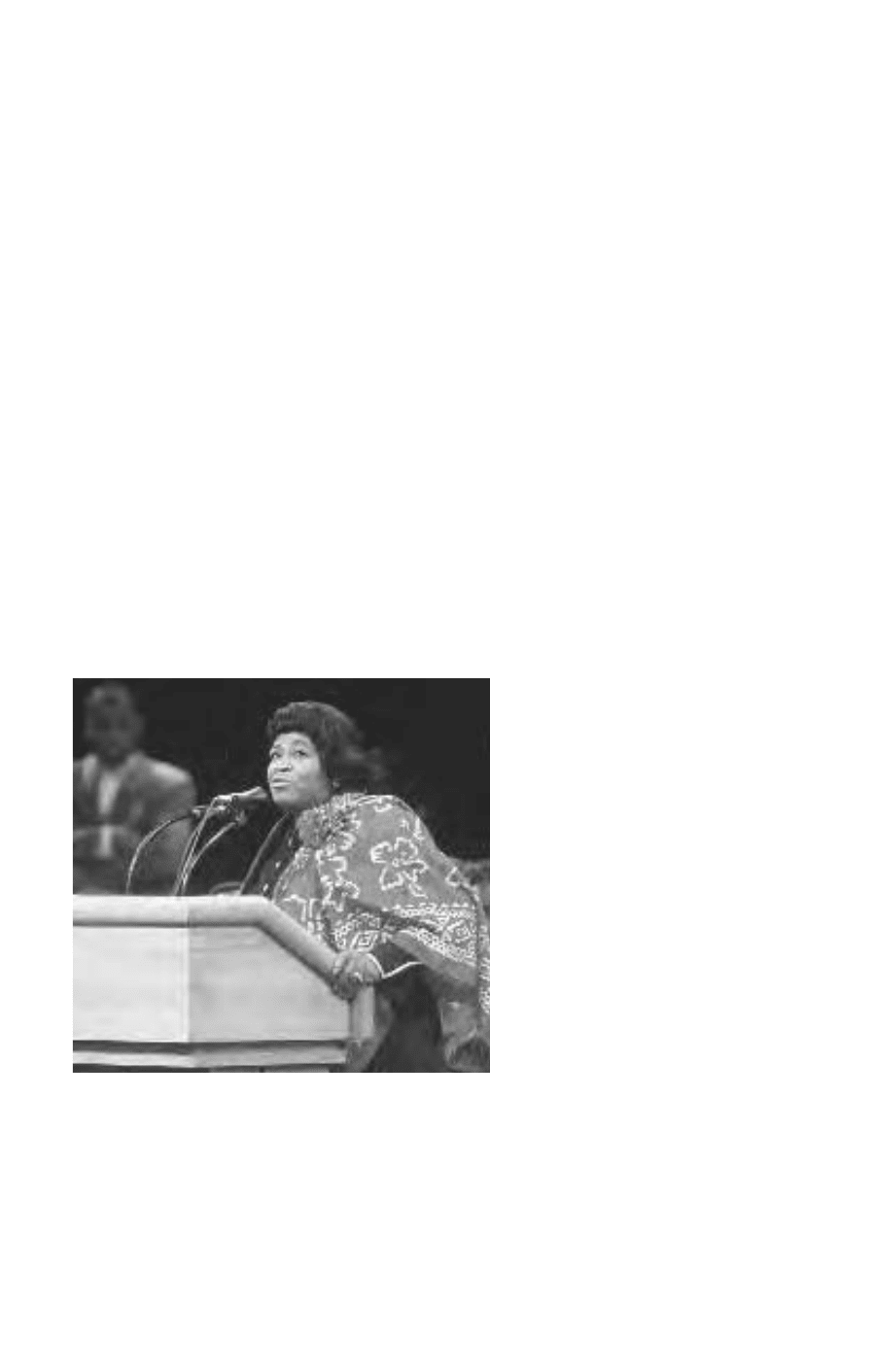Schenken Suzanne O’Dea. From Suffrage to the Senate: An Encyclopedia of American Women in Politics (2 Volumes)
Подождите немного. Документ загружается.


or manager can commit quid pro quo harassment because a coworker or
someone without supervisory authority cannot affect the victim’s job. There
only needs to be one event of this form of harassment for it to be illegal.
Hostile work environment harassment has been defined by the
EEOC and accepted by the U.S. Supreme Court in Meritor Savings Bank v.
Vinson (1986) as unwelcome conduct that “has the purpose or effect of
unreasonably interfering with an individual’s work performance or creat-
ing an intimidating, hostile, or offensive working environment.” Sexual
slurs and comments, sexually offensive images, and unwanted touching of
intimate body areas are all forms of hostile environment harassment. Un-
like quid pro quo harassment, hostile environment harassment does not
require that the person’s job is threatened by the harasser. Frequency and
severity are key to this form of harassment—the more often it occurs, the
less severe it must be to constitute harassment.
In Harris v. Forklift Systems (1993), the U.S. Supreme Court ruled
that employees do not need to show that the offensive sexual behavior left
them psychologically damaged or unable to perform their jobs. The Court
wrote: “So long as the environment would reasonably be perceived, and is
perceived, as hostile or abusive, there is no need for it also to be psycho-
logically injurious.” Although Meritor expanded the definition of sexual
harassment and Harris made a hostile environment easier to prove,
women who initiate legal remedies for workplace sexual harassment often
face public scorn and lengthy and expensive legal obstacles.
Sexual harassment gained national attention in 1991 when law pro-
fessor Anita Hill alleged that U.S. Supreme Court nominee Clarence
Thomas had sexually harassed her. In her testimony before the U.S. Sen-
ate Judiciary Committee, Hill described the humiliation and embarrass-
ment of being sexually harassed. The televised hearings prompted women
who had suffered experiences of sexual harassment to file complaints and
take other actions to stop the exploitation.
Two other sexual harassment cases also gained national attention in
the 1990s. Sexual harassment of women in the military gained national at-
tention following revelations in 1992 that women had been assaulted at
the 1991 convention of the Tailhook Association, a private association of
naval aviators. On one night, more than 100 association members were
involved in assaults that included the men grabbing or removing the
clothing of twenty-six women, half of them Navy officers, as they tried to
pass through a hallway. In the course of the weekend convention, eighty-
three women and seven men were assaulted. Navy lieutenant Paula
Coughlin, an admiral’s aide and helicopter pilot, feared that she would be
gang-raped, but she escaped after biting one of the men. Coughlin filed a
formal complaint, which resulted in two internal Navy investigations, but
Sexual Harassment 609

only two suspects were identified. The Department of Defense inspector
general conducted another investigation that resulted in several officers
being disciplined and others facing court martial proceedings, but all of
the cases were dismissed. No one involved was convicted of a crime.
The second sexual harassment case that gained national attention in-
volved Republican senator Bob Packwood of Oregon. Packwood, who had
long supported women’s issues and abortion rights, was accused of mak-
ing unwanted sexual advances toward women beginning in 1969. Twenty-
six women accused him of sexual misconduct, which he originally denied.
While the Senate Ethics Committee began investigating the allegations,
Packwood attempted to defend himself through references to his personal
diaries, leading the Senate to subpoena them. The revelations in his diaries
led to his resignation in 1995.
See also Civil Rights Act of 1964, Title VII; Employment Discrimination; Equal
Employment Opportunity Commission; Harris v. Forklift Systems; Hill, Anita
Faye; Meritor Savings Bank v. Vinson
References Bingham, Women on the Hill: Challenging the Culture of Congress
(1997); Fallon, “Sexual Harassment, Content, Neutrality, and the First Amend-
ment Dog That Didn’t Bark” (1995); Hoff, Law, Gender, and Injustice (1991);
Levy and Paludi, Workplace Sexual Harassment (1997); www.eeoc.gov/ facts/
fs-sex.html.
Shabazz, Hajj Bahiyah (Betty)
(1936–1997)
Widow of civil rights leader Malcolm X,
Betty Shabazz also became a national figure
in the civil rights movement. Born in De-
troit, Michigan, Shabazz attended Tuskegee
Institute, where she met Malcolm X during
her junior year. They married and had four
daughters. Shabazz was pregnant with
twins when she witnessed Malcolm X’s as-
sassination on 21 February 1965 in New
York City’s Audubon Ballroom. Shabazz
then focused her attention on raising their
daughters and completing her own educa-
tion. She earned a registered nursing degree from Brooklyn State Hospital
School of Nursing and her doctoral degree from the University of Massa-
chusetts in 1975.
A professor of health administration at Medgar Evers College, she
also served as the school’s director of institutional advancement and pub-
lic relations. Shabazz became a national figure through her public speak-
ing on education and issues of race relations.
610 Shabazz, Hajj Bahiyah (Betty)
Betty Shabazz,
widow of slain civil
rights leader Mal-
colm X, reconciled
her differences with
Islam leader Louis
Farrakhan, 1995
(Corbis/Robert
Maass)

See also Civil Rights Movement; Evers-Williams, Myrlie Louise Beasley
References Smith, ed., Powerful Black Women (1996).
Shaheen, Jeanne (b. 1947)
Democrat Jeanne Shaheen became governor of New Hampshire in 1997.
A member of the New Hampshire Senate from 1991 to 1996, Shaheen
passed health care reform legislation providing guarantees for adequate
hospital stays for women after childbirth, stabilizing health insurance
rates, and ending discrimination against people with preexisting condi-
tions. She helped open the electric utility industry to competition to help
lower the state’s electric rates and helped create the first state-sponsored
industrial research center.
In her campaign for governor, Shaheen pledged to apply for federal
grants for Goals 2000, a federal program that provides grants to states that
meet certain educational goals. She proposed raising the state’s cigarette
tax and permitting video poker machines at the state’s racetracks to help
fund public kindergarten classes, which were not universally available in
New Hampshire.
Born in St. Charles, Missouri, Jeanne Shaheen earned her bachelor’s
degree from Shippensburg University in 1969 and her master’s degree
from the University of Mississippi in 1973.
See also Governors, Women; State Legislatures, Women in
References Congressional Quarterly Almanac, 104th Congress, 2nd Session...
1996 (1997); www.state.nh.us/governor/bio.html.
Shalala, Donna Edna (b. 1941)
Democrat Donna Shalala became secretary of the U.S. Department of
Health and Human Services in 1993. She is the longest-serving secretary
of health and human services in U.S. history. Shalala began her political
career as treasurer and a director of New York City’s Municipal Assistance
Corporation, which worked to restore the city’s financial stability in the
mid-1970s. Assistant secretary for policy development and research at the
Department of Housing and Urban Development from 1977 to 1980, she
discovered that only 18 percent of the owner-occupied homes in the
United States were owned by women and began a “Women and Mortgage
Credit” program. The project held workshops that taught women the ad-
vantages and disadvantages of home ownership. She developed a women’s
policy and program staff, funded battered women’s shelters, and commis-
sioned studies of the housing needs of families headed by women. Shalala
explained: “Sex discrimination existed in rental housing, against families
with children, against elderly single women, against black and minority
Shalala, Donna Edna 611

women. We began to review all federal housing policies to assess their im-
pact on women.”
As secretary of health and human services, Shalala participated in re-
forming welfare and implemented the changes, gained approval of the
Children’s Health Insurance Program, and raised child immunization
rates to the highest in history. She campaigned against tobacco use and
sought to end the association between smokeless tobacco and professional
baseball, a project that included her throwing the first pitch (the full 60
feet, 6 inches) for the Orioles 1998 season. In addition to developing na-
tional initiatives to fight breast cancer and violence against women, she
worked for improved medications to treat acquired immunodeficiency
syndrome (AIDS) and tried to increase access to them.
Born in Cleveland, Ohio, Shalala earned her bachelor of arts degree
from Western College for Women in 1962. She volunteered for the Peace
Corps from 1962 to 1964, teaching at the University of Ahwaz in Iran. Af-
ter returning to the United States, Shalala taught at Syracuse University
while working on her doctoral degree, which she received in 1970 from
Syracuse University. Shalala taught at Bernard M. Baruch College from
1970 to 1972, when she began teaching at Teachers College at Columbia
University. She became president of Hunter College in 1980 and held the
position until 1988, when she became chancellor of the University of Wis-
consin at Madison, the first woman to head a Big Ten university.
See also Cabinets, Women in Presidential
References H. W. Wilson, Current Biography Yearbook, 1991 (1991); New York
Times, 15 January 1976; www.hhs.gov/about/bios/dhhssec.html.
Shaw, Anna Howard (1847–1919)
Anna Howard Shaw was president of the National American Woman Suf-
frage Association from 1904 to 1915, a period considered the doldrums
for the woman suffrage movement. The first woman ordained in the
Methodist Protestant Church as well as a physician, Shaw began her polit-
ical career as a lecturer for woman suffrage in 1883.
Born in Newcastle upon Tyne, England, Shaw moved to the United
States in 1851 with her parents, settling in Lawrence, Massachusetts. An
education was a priority for Shaw, but she was unable to attend high
school until she was twenty-three years old. Her ability to preach soon
came to the attention of a Methodist minister who invited her to join him
in his circuit, and she began her career as an itinerant preacher.
In 1873, Shaw entered Albion College, and while she continued to
preach, she also began lecturing on temperance. Three years later, she left
Albion before graduating and moved to Boston to attend Boston Univer-
612 Shaw, Anna Howard

sity Theological Seminary. After graduating in 1878, she received a call to
a church on Cape Cod. She applied to the Methodist Episcopal Confer-
ence for ordination in 1880, but the bishop refused to ordain her because
of her sex. Later that year, the Methodist Protestant Church ordained her.
Shaw decided that a medical degree would be useful in her ministries
and entered Boston University School of Medicine in 1882, graduating in
1886. She resigned her pastorate and earned her living as a lecturer on suf-
frage, temperance, and social purity. In 1887, the American Woman Suf-
frage Association hired her as its national lecturer. Shaw met Susan B. An-
thony when both women were lecturing in Kansas, leading Anthony to
hire her as the National American Woman Suffrage Association’s
Shaw, Anna Howard 613
Anna Howard Shaw,
president of the
National American
Woman Suffrage
Association, was both
a Methodist preacher
and a medical doctor,
1920 (Library of
Congress)

(NAWSA) national lecturer in 1890. Two years later, Shaw became
NAWSA’s vice president–at–large.
When Anthony resigned the presidency of NAWSA in 1900, Carrie
Chapman Catt became the group’s president, serving until 1904. Follow-
ing Catt’s resignation, Shaw became NAWSA president. During her tenure
from 1904 to 1915, Shaw increased the organization’s membership from
17,000 to 183,000 and its annual budget from $5,000 to almost $50,000.
In addition, the number of states with full woman suffrage grew from four
to eleven. Shaw also moved NAWSA’s headquarters from Warren, Ohio,
the home of NAWSA treasurer Harriet Taylor Upton, to New York. De-
spite these improvements in the organization and the increase in the
number of suffrage states, some suffrage leaders were dissatisfied with the
progress being made. They felt that with a more active and energetic cam-
paign, success would come more quickly.
Shaw’s approach to the presidency may have contributed to the cam-
paign’s pace. She used a democratic approach, seeking the opinions of the
board members before acting. She wrote long letters updating and con-
sulting them on an almost weekly basis, but with board members located
around the country, it was a slow process and an inefficient way to man-
age the association and conduct the campaign. NAWSA’s structure im-
paired quick action because it limited the president’s freedom to act by re-
quiring board or convention approval in many situations. In addition,
Shaw faced regional conflicts in the use of resources such as speakers and
money, as well as in the underlying goal of suffrage. Southern women, in
particular, wanted suffrage for whites only, resisting universal suffrage out
of racism. Another limit arose from Shaw’s personal situation: she could
not devote all of her time to NAWSA because she had to support herself
by lecturing around the country.
The overall strategy pursued by NAWSA at the time also created
problems. By attempting to conduct state campaigns across the country,
often supporting several efforts in one election year, NAWSA’s resources
were constantly drained. For those who believed passing a federal amend-
ment provided the best opportunity, the sometimes futile state amend-
ments appeared to be an unwise use of funds.
By 1912, dissatisfaction with the slow progress led to criticism of
Shaw and NAWSA. That year, NAWSA executive secretary Mary Ware
Dennett sought to change the association’s constitution and to reorganize
it, but her effort failed. Dennett then joined others in openly criticizing
Shaw, eventually leaving the organization out of frustration. In 1915,
Shaw resigned the presidency, at least in part as a result of the increased
and persistent criticism she faced.
Shaw chaired the Woman’s Committee of the Council of National
614 Shaw, Anna Howard

Defense from 1916 to 1918. Following the end of World War I, she lec-
tured on peace. In 1915 she wrote her autobiography, A Story of a Pioneer.
See also American Woman Suffrage Association; Anthony, Susan Brownell;
Catt, Carrie Clinton Lane Chapman; Dennett, Mary Coffin Ware; National
American Woman Suffrage Association; Suffrage
References Linkugel and Solomon, Anna Howard Shaw: Suffrage Orator and
Social Reformer (1991).
Shepherd, Karen (b. 1940)
Democrat Karen Shepherd of Utah served in the U.S. House of Represen-
tatives from 5 January 1993 to 3 January 1995. Shepherd entered electoral
politics through the state legislature, serving in the Utah Senate from 1991
to 1993. During her congressional campaign, Shepherd proposed a ten-
point plan for children, including fully funding Head Start and improving
the collection of child support payments. After losing her bid for a second
term to Enid Greene Waldholtz, Shepherd was a fellow at the Institute of
Politics at the John F. Kennedy School of Government at Harvard Univer-
sity. In 1996, President Bill Clinton appointed her to the International
Bank for Reconstruction and Development.
Born in Silver City, New Mexico, Karen Shepherd earned her bache-
lor of arts degree from the University of Utah in 1962 and her master of
arts degree from Brigham Young University in 1963. A former English
teacher, Shepherd was assistant director for Salt Lake County social ser-
vices from 1975 to 1976 and director from 1976 to 1978. Shepherd pub-
lished and edited Network magazine for working women from 1978 to
1984.
See also Congress, Women in; State Legislatures, Women in; Greene, Enid
References Congressional Quarterly, Politics in America 1994 (1993).
Sheppard-Towner Maternity and Infancy Protection Act of 1921
The first goal of newly enfranchised women following the passage of the
Nineteenth Amendment, the Sheppard-Towner Maternity and Infancy
Protection Act allocated federal money to states to reduce maternal and
infant mortality. In a 1917 study conducted by the Children’s Bureau, the
United States ranked seventeenth among twenty nations in maternal mor-
tality and eleventh in infant mortality.
In 1917, Julia Lathrop, head of the Children’s Bureau, recommended
federal aid to states to protect pregnant women and their infants. The next
year, Congresswoman Jeannette Rankin (R-MT) introduced a bill to pro-
vide education for pregnant women through pre- and postnatal care as
well as federal aid to states for hospital care, medical care, and visiting
Sheppard-Towner Maternity and Infancy Protection Act of 1921 615

nurses for new mothers and their infants. Rankin did not return to Con-
gress in 1919, but that year Congressman Horace Mann Towner (R-IA)
and Senator Morris Sheppard (D-TX) introduced a comparable measure.
In 1921, the Women’s Joint Congressional Committee developed grass-
roots support for a maternal and infant health bill by distributing pam-
phlets and by deluging members of Congress with letters and telegrams
in support of the Sheppard-Towner Act. The lobbying campaign in-
cluded Good Housekeeping magazine, which also encouraged women to
lobby Congress. Criticized by conservatives as a Bolshevik plan, the Shep-
pard-Towner Act was opposed by the American Medical Association
because its members wanted to maintain control over medical care de-
livery. The Women Patriots opposed the measure, also labeling it a Com-
munist plan.
The U.S. Senate passed the Sheppard-Towner Act in 1921, but the
chairman of the House committee handling the bill tried to kill it. Re-
publican National Committee vice chair Harriet Taylor Upton, however,
interceded on behalf of the bill, telling President Warren G. Harding that
delaying it alienated women. Wanting to please the new women voters,
Harding intervened on the bill’s behalf on two occasions at Upton’s re-
quest. Members of Congress supported the bill for the same reason: to
please women voters, whose strength as a voting bloc was unknown.
When the House passed the bill 279 to 39, the only woman in Congress,
Alice Robertson, voted against it.
The Sheppard-Towner Act offered each state $5,000, with another
$5,000 available to those states providing matching funds. Under the act,
child care conferences trained public health and visiting nurses, as did the
literature developed and distributed by the Children’s Bureau, which ad-
ministered the act’s provisions. In addition, nurses provided instruction
in hygiene to pregnant women and new mothers. By 1922, forty-one states
participated in the program, and eventually only Connecticut, Illinois,
and Massachusetts remained out of it. The program did make a difference
in infant mortality: in 1921 the infant death rate was 75 per 1,000 births;
after Sheppard-Towner, it was 64 per 1,000. The maternal death rate also
dropped.
In 1926, Congress extended the appropriation but included a sunset
clause for the program on 30 June 1929, and the program ended. Some
states continued to provide the services after the federal appropriations
ended. With the passage of the Social Security Act of 1935, the programs
were restored.
See also Abbott, Grace; Children’s Bureau; Lathrop, Julia; Rankin, Jeannette
Pickering; Robertson, Alice Mary; Upton, Harriet Taylor; Women’s Joint
Congressional Committee
616 Sheppard-Towner Maternity and Infancy Protection Act of 1921

References Lemons, The Woman Citizen: Social Feminism in the 1920s (1973);
Lindenmeyer, “A Right to Childhood”: The U.S. Children’s Bureau and Child
Welfare, 1912–1946 (1997).
Shirtwaist Workers Strike
The Shirtwaist Workers Strike, also known as the Uprising of the 20,000,
began on 24 November 1909, when 18,000 garment workers walked out of
almost 500 shops in Manhattan and Brooklyn. Eventually, about 20,000
garment workers were on strike. The strikers, who made the blouses that fe-
male clerical workers wore at the time, primarily worked in dirty, poorly lit,
unsafe factories for long hours at starvation wages. Required to purchase
their sewing needles and thread from the employer, they were fined for
making errors, arriving late at work, and other infringements of company
rules. Generally young women ages sixteen to twenty-five, the waist makers
were mostly Russian Jewish immigrants. The strikers wanted a 10 percent
wage increase and recognition of their union in contract negotiations.
Local 25 of the International Ladies’ Garment Workers’ Union led
the strike, and the Women’s Trade Union League (WTUL) provided sup-
port to the strikers. The WTUL, whose leaders included some of New
York’s wealthy socialites, offered its offices for a strike headquarters, stood
in picket lines with the strikers, and generated publicity for the cause. The
WTUL also helped raise money for food and for bail for the more than
700 strikers who were arrested. After strikers realized that New York gar-
ment makers were subcontracting work to Philadelphia factories, the
strike spread to that city.
Several small manufacturers relented and signed agreements that in-
cluded a fifty-two-hour workweek, limitations on overtime, and provision
of needles, thread, and other equipment and supplies. In addition, union
officials were given access to payroll records on a weekly basis. The agree-
ments covered about 10,000 workers, who returned to work. Larger man-
ufacturers, however, hired strikebreakers.
In late December, New York employers offered strikers a fifty-two-
hour workweek, four paid holidays, and sewing supplies. They agreed to
rehire strikers and pledged that they would not discriminate against union
members. The strikers rejected the offer because the employers did not
agree to recognize the union.
In early February 1910, the Philadelphia strike ended in an arbitrated
agreement that did not include the union shop. Ten thousand garment
workers, however, joined Local 15 of the International Ladies’ Garment
Workers’ Union.
The New York socialites who had supported the strike began to lose
interest in it, particularly after the strikers had rejected the December of-
Shirtwaist Workers Strike 617

fer. Without the WTUL’s support, the strikers increasingly suffered. The
union signed an agreement that included time-and-a-half pay for over-
time hours and a fifty-two-hour workweek and did not include union
recognition. Twenty thousand workers joined Local 25.
The largest strike of women workers at the time, the Shirtwaist
Workers Strike demonstrated that women could be organized into unions
and laid the foundation for the development of a strong union for women
garment workers.
See also Women’s Trade Union League
References Foner, Women and the American Labor Movement: From the First
Trade Unions to the Present (1982); Wertheimer, We Were There: The Story of
Working Women in America (1977).
Simmons, Althea T. L. (1924–1990)
Chief lobbyist for the National Association for the Advancement of Col-
ored People (NAACP) from 1979 until her death in 1990, Althea Simmons
began her career with the organization as volunteer executive secretary for
the Texas State Conference of NAACP and joined the staff in 1961 as field
secretary. Director of the NAACP’s 1964 voter registration drive, she also
served as the organization’s director for training from 1964 until 1974. As
NAACP national education director from 1974 to 1977, Simmons devel-
oped handbooks, pamphlets, and programs designed for black youth.
When she served as associate director of branch and field services from
1977 to 1979, her responsibilities included the network of local and state
branches, field staff, and other divisions.
NAACP’s chief lobbyist during the Reagan administration, Simmons
worked to prevent erosion of the 1964 Civil Rights Act and helped pass the
extension of the Voting Rights Act in 1982, considered the most important
civil rights legislation in nearly two decades. Simmons successfully lob-
bied for sanctions against South Africa to protest apartheid, and after
President Ronald Reagan vetoed the measure, she successfully lobbied for
Congress’s override of the veto. She also worked for the bill making Mar-
tin Luther King, Jr.’s birthday a national holiday.
Born in Shreveport, Louisiana, Althea Simmons earned her bachelor
of science degree from Southern University in 1945, her master’s degree
from the University of Illinois in 1951, and her law degree from Howard
University in 1956. She also studied at the University of California at Los
Angeles and the New School for Social Work, among other schools.
See also National Association for the Advancement of Colored People, Women
in the
References New York Times, 30 June 1987, 17 September 1990.
618 Simmons, Althea T. L.
